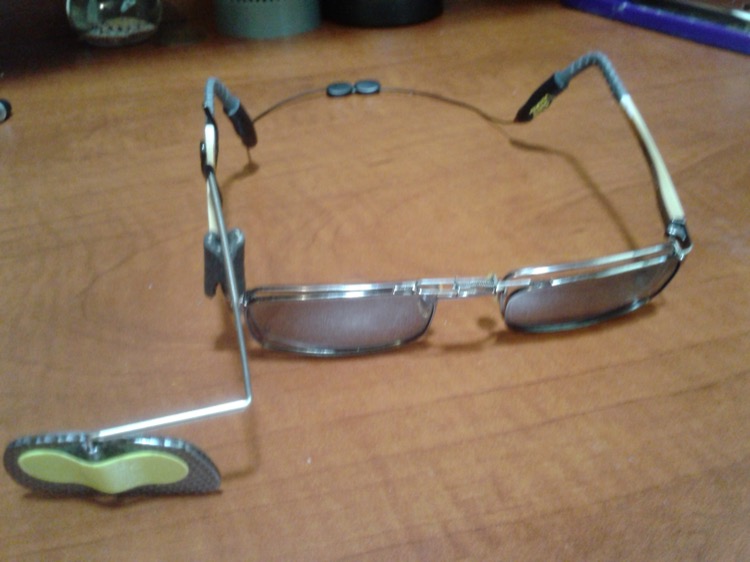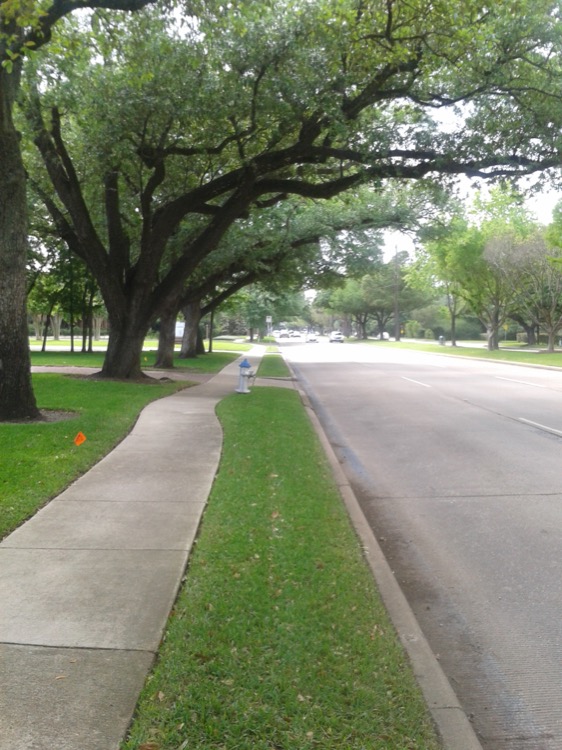by Lee Norris
Trails may be the gold standard for ultrarunning, however, as shown in UltraRunning Magazine’s 2017 reader survey, most readers live in an urban or suburban setting. For them, remote trails are an occasional treat and the bulk of everyday training occurs in an urban or suburban setting.
In this setting, a runner has three choices:
1) Endless repetitions around a park or bike trail until every root, pothole, and squirrel become close personal friends.
2) Driving somewhere to run, which means less time to run.
3) Making peace with concrete and asphalt and running on streets and sidewalks.
Option 3 has surprising rewards but requires special skills to avoid becoming a car hood ornament. After 40 years of running somewhere between 60,000 and 80,000 miles, 75% of that on asphalt or concrete (mostly in Houston – not the world’s most pedestrian-friendly city), I have several suggestions in various categories:
General Attitude
- Pay attention. The attention you need to pay to your surroundings when running is comparable to the attention you need to have when driving. Your speed is lower, but everyone else’s is not. Furthermore, you are more vulnerable when running, although in compensation, you can dodge much better. The car that hits you is the one you never saw coming.
- Assume that you are invisible. Most people are very nice and do not want to run over you, but they cannot avoid you if they cannot see you. This is particularly important at night, but is almost as important at noon. If you do not believe how invisible you are, just ask bicyclists and motorcyclists. Motorists are looking for cars, period. You are not a car, and hence, invisible.
- Be nice. At a minimum, don’t be a jerk. Outside of running meccas like Eugene, Boulder, Austin, or almost anywhere in California, you may be the only runner the driver sees that day. Like it or not, you represent the entire running community. If you are obnoxious, you make life harder for the rest of us. Be friendly, wave, and indicate thanks when someone goes out of their way to yield the right of way to you. Even under ample provocation, do not yell or make obscene gestures to motorists. Not only will niceness increase your chances of survival, it will make your run more pleasant.
- Be appropriately assertive. Do not be overly insistent on your right of way (see item 3), but neither be too deferential. You have as much right to be there as the motorist, but do not have the right to unreasonably impede his passage. Too deferential will get you ignored or pushed around. This one is a judgment call based on both the local road culture and your own personality.
Equipment
- Polarized sunglasses or clip-ons. Polarized sunglasses take the glare off windshields so you can see the faces of oncoming drivers. (You are running facing traffic, aren’t you?) It is amazing how well you can evaluate the mental state of a face approaching you at 100 ft/sec. This ability is so useful that I always use polarized clip-ons unless it’s too dark to see with them on.
- Rear view mirror. You know, the type that bicyclists clip on their helmet or glasses. I know this seems really dorky, but it’s very useful. You can check out what is approaching from behind without twisting around and tripping on the pothole just in front of you. The mirror should be on the right temple piece. Glancing in the mirror is instinctual since this is the same motion you use with the rear view mirror in your car. In addition, it focuses what is coming up behind you on your right side. This is the zone of highest threat. Rear view mirrors are even useful in race situations. You can easily check out the runners behind you while avoiding tripping hazards. You can even see the competition attempting to overtake you. (When you are an old guy like me everyone is overtaking you.)
- Reflectors, reflectors, reflectors. If you run at night, it is a whole new ball game. Use reflectors, lights, arm and wrist bands, vests, whatever. During the day you should also have reflectors on the backs of your shoes and hat, and any suitable equipment that you always wear. Even your cell phone carrier is a good place. There are two reasons for this: 1) you may get caught in the dark when you did not expect to and do not have your night-visibility kit on you, and 2) reflectors, particularly the day-glow-green and international orange ones are surprisingly visible and attention-getting during the day.
- Bright, gaudy clothing. Almost nothing is more attention-getting. If people think that you have the world’s worst fashion sense, that means they saw you and are less likely to run into you.

My eyeglasses with $15 polarized clip-ons and rear-view mirror attached to the right temple. Note reflector on the back of the mirror. Photo: Lee Norris

A rear view mirror lets you see your most vulnerable area: what’s behind and to your right and can be particularly useful on residential streets with no sidewalks and lots of parked cars. Photo: Lee Norris
Running Techniques
- Run facing traffic. You are eyeball-to-eyeball with oncoming drivers and the traffic coming up from behind you will be on the other side of the road. Mischief-inclined drivers tend to be more polite when you are staring right at them.
- Crossing freeways. Freeways require special attention. I assume you are crossing at overpasses or underpasses. Freeways are not the problem; service roads are the problem. If you are facing traffic, the first service road will be easy. The only way that you will encounter traffic is from your left, and they will generally be stopped at the light. The second service road will be the most dangerous situation you will encounter. Full-alert conditions are required, because traffic can come at you either from the service road on your right, turning right-on-red in front of you, or turning left from behind you. You have to look three directions at the same time, so heads up! Major throughways with divided medians are identical to freeways from your point of view. They are two service roads without the freeway.
- The dreaded left turn. The previously mentioned left-turn-from-behind-you requires elaboration. Service roads and major streets generally have left turn lanes and green-arrow signals. Drivers will frequently try to beat a green turning-arrow that is changing to red. As a result, they will be diagonally crossing the intersection at high speed. Furthermore, they will be approaching from the blind spot over your right shoulder. This can be a real widowmaker. Never, ever, cross a major intersection without looking over your right shoulder to be sure that a car is not approaching at high speed. In 40 years of running, this is the only scenario in which I nearly got hit.
- Drivers exiting a parking lot. Drivers exiting a parking lot are looking to their left, and not looking at or for you. Do not run in front of them unless you have made eye contact, and maybe not even then. It is much better to run behind them, even if you have to make a twenty-foot detour. If there is a line of cars waiting to exit the lot, run between the first and second car. The second car is looking at the first car and will see you. Remember to also look for vehicles entering the lot before venturing out from behind that first exiting vehicle. To not do so is dangerous. When you pass behind the exiting vehicle, you can neither see nor be seen by drivers entering the lot, particularly if they are in a truck, van, or SUV. Stop and peer around the vehicle you are running behind to be sure that no one is entering and about to cross your path before you continue across.
- Run carefully through persistently wet patches. Water systems leak, and there will be persistently wet patches, particularly on sidewalks. In warm, humid climates like Houston, any persistently wet patch will have a layer of algal slime on it. If there is no slime, there will be mud. Either way, you will have no traction. Soft-pedal across, and do not try to make any change in direction.

Heads-up on busy freeway crossings and intersections! Remember to look over your right shoulder, particularly for the second service road crossing. Photo: Lee Norris
The Joys of Urban/Suburban Running
Running on asphalt and concrete is really not as dangerous and scary as I have depicted it. You just have to be a little careful out there. There are several compensations that cause me, at least some of the time, to enjoy city running more than trail running.
- More variety. Some trails have a lot of variety in terrain, vegetation, and view. Many more do not. Outside mountainous areas, trails tend to be in riparian woodlands. This is true, if for no other reason than because the flood potential of the nearby creek or river suppresses development and makes for continuous corridors. This is pretty, but after a few miles, if you have seen one tree you have seen them all. By contrast, urban and suburban landscapes are more varied.
- More wildlife. Not many squirrels, rabbits and deer, but lots of birds. And of course, many more of the most bizarre animal of all: people. The upside of being invisible is that you are just another runner and people do ignore you.
- More accessible. Put on your shoes, step out your door and run, no driving required. If you are travelling, phere is no better way to see a new city than to run it.
Exercise a little caution and have fun out there!


1 comment
It is sort of tacky to comment on your own article, but my daughter raised a very good point on the Drivers-exiting-a-parking-lot-item. When you pass behind the first vehicle exiting the parking lot, you can neither see nor be seen by drivers entering the lot, particularly if they are in a truck, van, or SUV (75% of the vehicles in Texas). Stop and peer around the vehicle you are running behind and be sure that no one is entering and crossing your path before you venture forth. Not doing so is a good way to get squashed. I should have put that in the original article.
I hope this post gets lots of comments, both positive and negative. I surely left stuff out and welcome additions and disagreements. Discussion makes everyone safer.
Comments are closed.